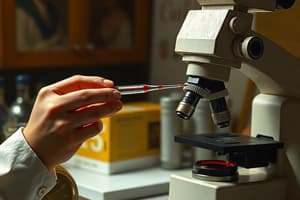Podcast
Questions and Answers
What is the principle behind cell counting and sizing in the Electrical Impedance (Coulter principle) method?
What is the principle behind cell counting and sizing in the Electrical Impedance (Coulter principle) method?
- Detection and measurement of changes in electrical resistance produced by cells as they traverse a small aperture (correct)
- Detection and measurement of changes in magnetic field induced by cells in a closed chamber
- Detection and measurement of light scatter by cells passing through a detection system
- Detection and measurement of changes in temperature caused by cells as they pass through a sensor
What type of blood specimen is required for cell counting using the Electrical Impedance method?
What type of blood specimen is required for cell counting using the Electrical Impedance method?
- Arterial blood in EDTA, undiluted capillary blood
- Whole venous blood in heparinized capillary blood
- Whole venous blood in EDTA, diluted/heparinized capillary blood (correct)
- Arterial blood in heparinized capillary blood
What is the function of the lysing reagent in the context of cell counting using the Electrical Impedance method?
What is the function of the lysing reagent in the context of cell counting using the Electrical Impedance method?
- Stain the cells for better visibility under the microscope
- Neutralize the electrical charge of the cells
- Prevent clotting of the blood specimen
- Dissolve RBC stroma when performing WBC counts (correct)
What is the purpose of the electrolyte in the context of cell counting using the Electrical Impedance method?
What is the purpose of the electrolyte in the context of cell counting using the Electrical Impedance method?
What is the role of the cleaning agents in the Electrical Impedance method of cell counting?
What is the role of the cleaning agents in the Electrical Impedance method of cell counting?
Flashcards are hidden until you start studying
Study Notes
Electrical Impedance (Coulter Principle)
- The principle behind cell counting and sizing is based on changes in electrical impedance (resistance to alternating current) when a cell passes through a narrow tube.
Sample Requirements
- The Electrical Impedance method requires a whole blood specimen.
Lysing Reagent
- The lysing reagent is used to dissolve red blood cells and platelets, leaving only white blood cells intact for counting.
Electrolyte
- The electrolyte is necessary to facilitate the flow of electrical current and enable detection of cells as they pass through the tube.
Cleaning Agents
- Cleaning agents are used to prevent clogging of the tube and ensure accurate counting by removing any residual cells and debris.
Studying That Suits You
Use AI to generate personalized quizzes and flashcards to suit your learning preferences.




